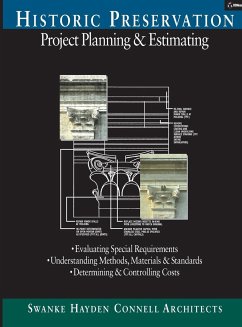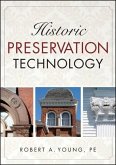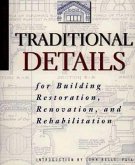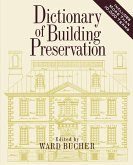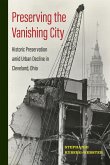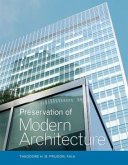- Gebundenes Buch
- Merkliste
- Auf die Merkliste
- Bewerten Bewerten
- Teilen
- Produkt teilen
- Produkterinnerung
- Produkterinnerung
With over a million commercial/institutional buildings and countless residences erected in the U.S. prior to World War II, more and more AECs and facility professionals are having to manage and estimate preservation of these projects. This book provides crucial information on: Applicable standards and financingSite survey and documentation methodsProtecting finishes and featuresHazardous materialsIdentifying and qualifying specialty contractorsMechanical/electrical systems upgradesIncludes a reference guide on old building materials and how to restore them The Cost Estimating section explains…mehr
Andere Kunden interessierten sich auch für
![Historic Preservation Technology Historic Preservation Technology]() Robert A. YoungHistoric Preservation Technology101,99 €
Robert A. YoungHistoric Preservation Technology101,99 €![Traditional Details Traditional Details]() Charles George RamseyTraditional Details101,99 €
Charles George RamseyTraditional Details101,99 €![Dictionary of Building Preservation Dictionary of Building Preservation]() Dictionary of Building Preservation86,99 €
Dictionary of Building Preservation86,99 €![Preserving the Vanishing City: Historic Preservation amid Urban Decline in Cleveland, Ohio Preserving the Vanishing City: Historic Preservation amid Urban Decline in Cleveland, Ohio]() Stephanie Ryberg-WebsterPreserving the Vanishing City: Historic Preservation amid Urban Decline in Cleveland, Ohio117,99 €
Stephanie Ryberg-WebsterPreserving the Vanishing City: Historic Preservation amid Urban Decline in Cleveland, Ohio117,99 €![Preservation of Modern Architecture Preservation of Modern Architecture]() Theodore PrudonPreservation of Modern Architecture147,99 €
Theodore PrudonPreservation of Modern Architecture147,99 €![Preservation Is Overtaking Us Preservation Is Overtaking Us]() Rem KoolhaasPreservation Is Overtaking Us18,99 €
Rem KoolhaasPreservation Is Overtaking Us18,99 €![Human-Centered Built Environment Heritage Preservation Human-Centered Built Environment Heritage Preservation]() Human-Centered Built Environment Heritage Preservation197,99 €
Human-Centered Built Environment Heritage Preservation197,99 €-
-
-
With over a million commercial/institutional buildings and countless residences erected in the U.S. prior to World War II, more and more AECs and facility professionals are having to manage and estimate preservation of these projects. This book provides crucial information on: Applicable standards and financingSite survey and documentation methodsProtecting finishes and featuresHazardous materialsIdentifying and qualifying specialty contractorsMechanical/electrical systems upgradesIncludes a reference guide on old building materials and how to restore them The Cost Estimating section explains how to assemble a reliable, detailed estimate. The book also covers budgeting for future maintenance of the restored building. Authored and reviewed by a team of leading experts in the field of historic preservation, restoration, and rehabilitation - authorities recognized nationwide in design and construction.
Hinweis: Dieser Artikel kann nur an eine deutsche Lieferadresse ausgeliefert werden.
Hinweis: Dieser Artikel kann nur an eine deutsche Lieferadresse ausgeliefert werden.
Produktdetails
- Produktdetails
- Verlag: Wiley
- Seitenzahl: 720
- Erscheinungstermin: 26. September 2000
- Englisch
- Abmessung: 286mm x 221mm x 43mm
- Gewicht: 2046g
- ISBN-13: 9780876295731
- ISBN-10: 0876295731
- Artikelnr.: 21505790
- Herstellerkennzeichnung
- Libri GmbH
- Europaallee 1
- 36244 Bad Hersfeld
- gpsr@libri.de
- Verlag: Wiley
- Seitenzahl: 720
- Erscheinungstermin: 26. September 2000
- Englisch
- Abmessung: 286mm x 221mm x 43mm
- Gewicht: 2046g
- ISBN-13: 9780876295731
- ISBN-10: 0876295731
- Artikelnr.: 21505790
- Herstellerkennzeichnung
- Libri GmbH
- Europaallee 1
- 36244 Bad Hersfeld
- gpsr@libri.de
Swanke Hayden Connell Architects was an international architecture, interiors and historic preservation firm with U.S. headquarters in New York City.
Acknowledgments.
About the Authors.
Introduction.
Part I: Special Considerations of Historic Preservation Projects.
Chapter 1: What Makes a Property Historic?
Historic Landmark Criteria and Status.
Landmark Preservation Agencies.
National Preservation Agencies.
Summary.
Chapter 2: The Project Phases & Design Team Services.
The Preservation Team.
Project Phases and Construction Document Development.
Project Design Services and Costs.
Documentation.
Field Inspection.
Non-Destructive Investigation Techniques.
Intrusive or Destructive Evaluation Techniques.
Field Documentation Methods.
Summary.
Chapter 3: Hazardous Materials: Identification & Containment.
Hazardous Substances Common in Old Buildings.
Regulations.
Assessment.
Asbestos.
Lead.
Polychlorinated Biphenyls.
Underground Storage Tanks.
Radon.
Animal Matter.
Summary.
Chapter 4: Conformance with Codes & Standards.
Building Codes.
The Americans with Disabilities Act.
Laws Governing National Historic Preservation Programs.
Laws Governing National Historic Landmarks.
Government Agencies Affected by Federal Historic Preservation Laws.
The Section 106 Process.
Secretary of the Interior's Standards for the Treatment of Historic
Properties.
Summary.
Chapter 5: Restoring Archaic Materials.
Determination of Original Materials.
Procurement of Archaic Materials.
Role of Craftspeople and Specialty Contractors.
Chapter 6: Upgrading Building Systems.
Structural Systems.
Mechanical, Plumbing, Electrical, and Data Systems.
Fire Protection and Alarm Systems.
Security Systems.
Elevators.
Windows.
Curtain Walls.
Doors.
Door Hardware.
Bird Control.
Chapter 7: Access to & Protection of the Site.
Determining Access Requirements.
Responsibility for Access Provision.
Safety.
Scaffolding.
Man Lifts.
Rappelling.
Protecting Existing Components and Finishes.
Summary.
Chapter 8: Mechanical/Electrical Systems.
Scope of Work.
Qualifying and Assembling the Project Team.
Investigation.
Design Goals.
Electrical Design Issues.
Lighting.
Fire Protection Design Considerations.
HVAC Design Considerations.
Plumbing Design Considerations.
Specifications.
Installation.
Maintenance of Mechanical/Electrical Equipment.
Summary.
Part II: Historic Building Materials: Assessment & Repair.
Chapter 9: Metals.
Lead.
Zinc.
Copper.
Bronze.
Brass.
Nickel.
Nickel Silver.
Monel Metal.
Iron.
Wrought Iron.
Cast Iron.
Mild Steel.
Structural Steel.
Stainless Steel.
Weathering Steel.
Aluminum.
Summary.
Chapter 10: Masonry.
Brick.
Stone.
Architectural Terra Cotta.
Glass Block.
Mortar.
Structural Clay Tile.
Thin Stone Veneer.
Simulated Masonry.
Gypsum Block or Tile.
Cast Stone.
Summary.
Chapter 11: Concrete.
Concrete Block.
Shotcrete.
Architectural Precast Concrete.
Prestressed Concrete.
Summary.
Chapter 12: Wood & Plastics.
Wood.
Plastic.
Summary.
Chapter 13: Glass.
Plate Glass.
Figured Glass.
Prismatic Glass.
Vault Lights (Sidewalk Lights).
Pigmented Structural Glass.
Leaded Glass.
Summary.
Chapter 14: Floor Finishes.
Terrazzo.
Ceramic Tile.
Cork Tile.
Rubber Flooring.
Linoleum.
Vinyl Tile.
Summary.
Chapter 15: Wall & Ceiling Finishes.
Plaster.
Gypsum Board.
Acoustical Materials.
Summary.
Chapter 16: Roofing, Stucco, & Sealants.
Wood Shingles and Shakes.
Asphalt Shingles.
Cement Shingles.
Slate.
Clay Tile.
Metal Roofing Systems.
Stucco (Cement Plaster).
Building Sealants.
Summary.
Chapter 17: Paint Techniques, Wallpaper, & Gilding.
Paint.
Decorative Paint Techniques.
Wallpapering.
Gilding.
Summary.
Part III: Contract Administration.
Chapter 18: Preparing the Construction Documents.
Construction Documents.
Mock-ups to Evaluate Proposed Design Solutions.
Specifications.
Unknown and Non-Quantifiable Work.
Bidding Documents.
General Contractor Qualifications.
Chapter 19: The Bidding Process.
Open Versus Closed Competitive Selection.
Bidding Documents.
Instructions to Bidders.
Direct Selection of the Contractor.
Pre-Qualification of Contractors.
Pre-Bid Meeting.
Types of Contracts.
Summary.
Chapter 20: Quality Assurance & Contractor Selection.
Quality Assurance and Quality Control.
The Role of Team Members in a Quality Project.
Partnering.
Qualifying Bidders, Subcontractors, and Superintendents.
Summary.
Part IV: Estimating Construction & Maintenance Costs.
Chapter 21: Costs Unique to Historic Projects.
Requirements in the Project Planning Phase.
General Requirements.
Other Factors That Affect Costs.
Unforeseen Conditions.
Summary.
Chapter 22: The Unit Price Estimate.
Site Visit and Evaluation.
Estimate Preparation Considerations.
Creating the Unit Price Estimate.
Estimating the 16 MasterFormat Divisions.
Summary.
Chapter 23: Funding Sources & Investment Considerations.
Developing the Budget and Scope of Work.
Investment Tax Credits.
Other Tax Incentives for Historic Preservation.
Strategies for Generating Funds.
Investment Considerations.
Chapter 24: Establishing a Maintenance Budget.
Forecasting Costs.
Building Study Components.
Existing Building Analysis.
Replacement Reserve Study.
Using a 20-Year Spreadsheet.
Annual Building Reviews.
Developing an EBA or RRS.
The Project Spreadsheet.
Preventive Maintenance System (PMS).
Who Performs These Studies?
Summary.
Part V: Case Study.
Chapter 25: Commercial Rehabilitation of a Historic Building: The Candler
Building.
Historical Significance.
Building Description.
Existing Conditions.
Proposed Project.
Project Budget and Financial Incentives.
Schedule and Phasing.
Exterior Rehabilitation.
Base Building Interior Rehabilitation.
Other Issues.
A Final Word.
Appendix.
A: National Register Evaluation Criteria, Benefits of Listing, & Nomination
Process.
B: Major Federal Statutes.
C: Resources.
C.1: Professional, Trade, Advocacy, & Other Organizations.
C.2: Federal Organizations.
C.3: State Historic Preservation Officers.
C.4: State Organizations.
C.5: Funding Organizations.
D. Non-Destructive Evaluation Techniques.
E. Further Study: Education & Resources.
Bibliography & Recommended Reading.
Glossary & Index.
About the Authors.
Introduction.
Part I: Special Considerations of Historic Preservation Projects.
Chapter 1: What Makes a Property Historic?
Historic Landmark Criteria and Status.
Landmark Preservation Agencies.
National Preservation Agencies.
Summary.
Chapter 2: The Project Phases & Design Team Services.
The Preservation Team.
Project Phases and Construction Document Development.
Project Design Services and Costs.
Documentation.
Field Inspection.
Non-Destructive Investigation Techniques.
Intrusive or Destructive Evaluation Techniques.
Field Documentation Methods.
Summary.
Chapter 3: Hazardous Materials: Identification & Containment.
Hazardous Substances Common in Old Buildings.
Regulations.
Assessment.
Asbestos.
Lead.
Polychlorinated Biphenyls.
Underground Storage Tanks.
Radon.
Animal Matter.
Summary.
Chapter 4: Conformance with Codes & Standards.
Building Codes.
The Americans with Disabilities Act.
Laws Governing National Historic Preservation Programs.
Laws Governing National Historic Landmarks.
Government Agencies Affected by Federal Historic Preservation Laws.
The Section 106 Process.
Secretary of the Interior's Standards for the Treatment of Historic
Properties.
Summary.
Chapter 5: Restoring Archaic Materials.
Determination of Original Materials.
Procurement of Archaic Materials.
Role of Craftspeople and Specialty Contractors.
Chapter 6: Upgrading Building Systems.
Structural Systems.
Mechanical, Plumbing, Electrical, and Data Systems.
Fire Protection and Alarm Systems.
Security Systems.
Elevators.
Windows.
Curtain Walls.
Doors.
Door Hardware.
Bird Control.
Chapter 7: Access to & Protection of the Site.
Determining Access Requirements.
Responsibility for Access Provision.
Safety.
Scaffolding.
Man Lifts.
Rappelling.
Protecting Existing Components and Finishes.
Summary.
Chapter 8: Mechanical/Electrical Systems.
Scope of Work.
Qualifying and Assembling the Project Team.
Investigation.
Design Goals.
Electrical Design Issues.
Lighting.
Fire Protection Design Considerations.
HVAC Design Considerations.
Plumbing Design Considerations.
Specifications.
Installation.
Maintenance of Mechanical/Electrical Equipment.
Summary.
Part II: Historic Building Materials: Assessment & Repair.
Chapter 9: Metals.
Lead.
Zinc.
Copper.
Bronze.
Brass.
Nickel.
Nickel Silver.
Monel Metal.
Iron.
Wrought Iron.
Cast Iron.
Mild Steel.
Structural Steel.
Stainless Steel.
Weathering Steel.
Aluminum.
Summary.
Chapter 10: Masonry.
Brick.
Stone.
Architectural Terra Cotta.
Glass Block.
Mortar.
Structural Clay Tile.
Thin Stone Veneer.
Simulated Masonry.
Gypsum Block or Tile.
Cast Stone.
Summary.
Chapter 11: Concrete.
Concrete Block.
Shotcrete.
Architectural Precast Concrete.
Prestressed Concrete.
Summary.
Chapter 12: Wood & Plastics.
Wood.
Plastic.
Summary.
Chapter 13: Glass.
Plate Glass.
Figured Glass.
Prismatic Glass.
Vault Lights (Sidewalk Lights).
Pigmented Structural Glass.
Leaded Glass.
Summary.
Chapter 14: Floor Finishes.
Terrazzo.
Ceramic Tile.
Cork Tile.
Rubber Flooring.
Linoleum.
Vinyl Tile.
Summary.
Chapter 15: Wall & Ceiling Finishes.
Plaster.
Gypsum Board.
Acoustical Materials.
Summary.
Chapter 16: Roofing, Stucco, & Sealants.
Wood Shingles and Shakes.
Asphalt Shingles.
Cement Shingles.
Slate.
Clay Tile.
Metal Roofing Systems.
Stucco (Cement Plaster).
Building Sealants.
Summary.
Chapter 17: Paint Techniques, Wallpaper, & Gilding.
Paint.
Decorative Paint Techniques.
Wallpapering.
Gilding.
Summary.
Part III: Contract Administration.
Chapter 18: Preparing the Construction Documents.
Construction Documents.
Mock-ups to Evaluate Proposed Design Solutions.
Specifications.
Unknown and Non-Quantifiable Work.
Bidding Documents.
General Contractor Qualifications.
Chapter 19: The Bidding Process.
Open Versus Closed Competitive Selection.
Bidding Documents.
Instructions to Bidders.
Direct Selection of the Contractor.
Pre-Qualification of Contractors.
Pre-Bid Meeting.
Types of Contracts.
Summary.
Chapter 20: Quality Assurance & Contractor Selection.
Quality Assurance and Quality Control.
The Role of Team Members in a Quality Project.
Partnering.
Qualifying Bidders, Subcontractors, and Superintendents.
Summary.
Part IV: Estimating Construction & Maintenance Costs.
Chapter 21: Costs Unique to Historic Projects.
Requirements in the Project Planning Phase.
General Requirements.
Other Factors That Affect Costs.
Unforeseen Conditions.
Summary.
Chapter 22: The Unit Price Estimate.
Site Visit and Evaluation.
Estimate Preparation Considerations.
Creating the Unit Price Estimate.
Estimating the 16 MasterFormat Divisions.
Summary.
Chapter 23: Funding Sources & Investment Considerations.
Developing the Budget and Scope of Work.
Investment Tax Credits.
Other Tax Incentives for Historic Preservation.
Strategies for Generating Funds.
Investment Considerations.
Chapter 24: Establishing a Maintenance Budget.
Forecasting Costs.
Building Study Components.
Existing Building Analysis.
Replacement Reserve Study.
Using a 20-Year Spreadsheet.
Annual Building Reviews.
Developing an EBA or RRS.
The Project Spreadsheet.
Preventive Maintenance System (PMS).
Who Performs These Studies?
Summary.
Part V: Case Study.
Chapter 25: Commercial Rehabilitation of a Historic Building: The Candler
Building.
Historical Significance.
Building Description.
Existing Conditions.
Proposed Project.
Project Budget and Financial Incentives.
Schedule and Phasing.
Exterior Rehabilitation.
Base Building Interior Rehabilitation.
Other Issues.
A Final Word.
Appendix.
A: National Register Evaluation Criteria, Benefits of Listing, & Nomination
Process.
B: Major Federal Statutes.
C: Resources.
C.1: Professional, Trade, Advocacy, & Other Organizations.
C.2: Federal Organizations.
C.3: State Historic Preservation Officers.
C.4: State Organizations.
C.5: Funding Organizations.
D. Non-Destructive Evaluation Techniques.
E. Further Study: Education & Resources.
Bibliography & Recommended Reading.
Glossary & Index.
Acknowledgments.
About the Authors.
Introduction.
Part I: Special Considerations of Historic Preservation Projects.
Chapter 1: What Makes a Property Historic?
Historic Landmark Criteria and Status.
Landmark Preservation Agencies.
National Preservation Agencies.
Summary.
Chapter 2: The Project Phases & Design Team Services.
The Preservation Team.
Project Phases and Construction Document Development.
Project Design Services and Costs.
Documentation.
Field Inspection.
Non-Destructive Investigation Techniques.
Intrusive or Destructive Evaluation Techniques.
Field Documentation Methods.
Summary.
Chapter 3: Hazardous Materials: Identification & Containment.
Hazardous Substances Common in Old Buildings.
Regulations.
Assessment.
Asbestos.
Lead.
Polychlorinated Biphenyls.
Underground Storage Tanks.
Radon.
Animal Matter.
Summary.
Chapter 4: Conformance with Codes & Standards.
Building Codes.
The Americans with Disabilities Act.
Laws Governing National Historic Preservation Programs.
Laws Governing National Historic Landmarks.
Government Agencies Affected by Federal Historic Preservation Laws.
The Section 106 Process.
Secretary of the Interior's Standards for the Treatment of Historic
Properties.
Summary.
Chapter 5: Restoring Archaic Materials.
Determination of Original Materials.
Procurement of Archaic Materials.
Role of Craftspeople and Specialty Contractors.
Chapter 6: Upgrading Building Systems.
Structural Systems.
Mechanical, Plumbing, Electrical, and Data Systems.
Fire Protection and Alarm Systems.
Security Systems.
Elevators.
Windows.
Curtain Walls.
Doors.
Door Hardware.
Bird Control.
Chapter 7: Access to & Protection of the Site.
Determining Access Requirements.
Responsibility for Access Provision.
Safety.
Scaffolding.
Man Lifts.
Rappelling.
Protecting Existing Components and Finishes.
Summary.
Chapter 8: Mechanical/Electrical Systems.
Scope of Work.
Qualifying and Assembling the Project Team.
Investigation.
Design Goals.
Electrical Design Issues.
Lighting.
Fire Protection Design Considerations.
HVAC Design Considerations.
Plumbing Design Considerations.
Specifications.
Installation.
Maintenance of Mechanical/Electrical Equipment.
Summary.
Part II: Historic Building Materials: Assessment & Repair.
Chapter 9: Metals.
Lead.
Zinc.
Copper.
Bronze.
Brass.
Nickel.
Nickel Silver.
Monel Metal.
Iron.
Wrought Iron.
Cast Iron.
Mild Steel.
Structural Steel.
Stainless Steel.
Weathering Steel.
Aluminum.
Summary.
Chapter 10: Masonry.
Brick.
Stone.
Architectural Terra Cotta.
Glass Block.
Mortar.
Structural Clay Tile.
Thin Stone Veneer.
Simulated Masonry.
Gypsum Block or Tile.
Cast Stone.
Summary.
Chapter 11: Concrete.
Concrete Block.
Shotcrete.
Architectural Precast Concrete.
Prestressed Concrete.
Summary.
Chapter 12: Wood & Plastics.
Wood.
Plastic.
Summary.
Chapter 13: Glass.
Plate Glass.
Figured Glass.
Prismatic Glass.
Vault Lights (Sidewalk Lights).
Pigmented Structural Glass.
Leaded Glass.
Summary.
Chapter 14: Floor Finishes.
Terrazzo.
Ceramic Tile.
Cork Tile.
Rubber Flooring.
Linoleum.
Vinyl Tile.
Summary.
Chapter 15: Wall & Ceiling Finishes.
Plaster.
Gypsum Board.
Acoustical Materials.
Summary.
Chapter 16: Roofing, Stucco, & Sealants.
Wood Shingles and Shakes.
Asphalt Shingles.
Cement Shingles.
Slate.
Clay Tile.
Metal Roofing Systems.
Stucco (Cement Plaster).
Building Sealants.
Summary.
Chapter 17: Paint Techniques, Wallpaper, & Gilding.
Paint.
Decorative Paint Techniques.
Wallpapering.
Gilding.
Summary.
Part III: Contract Administration.
Chapter 18: Preparing the Construction Documents.
Construction Documents.
Mock-ups to Evaluate Proposed Design Solutions.
Specifications.
Unknown and Non-Quantifiable Work.
Bidding Documents.
General Contractor Qualifications.
Chapter 19: The Bidding Process.
Open Versus Closed Competitive Selection.
Bidding Documents.
Instructions to Bidders.
Direct Selection of the Contractor.
Pre-Qualification of Contractors.
Pre-Bid Meeting.
Types of Contracts.
Summary.
Chapter 20: Quality Assurance & Contractor Selection.
Quality Assurance and Quality Control.
The Role of Team Members in a Quality Project.
Partnering.
Qualifying Bidders, Subcontractors, and Superintendents.
Summary.
Part IV: Estimating Construction & Maintenance Costs.
Chapter 21: Costs Unique to Historic Projects.
Requirements in the Project Planning Phase.
General Requirements.
Other Factors That Affect Costs.
Unforeseen Conditions.
Summary.
Chapter 22: The Unit Price Estimate.
Site Visit and Evaluation.
Estimate Preparation Considerations.
Creating the Unit Price Estimate.
Estimating the 16 MasterFormat Divisions.
Summary.
Chapter 23: Funding Sources & Investment Considerations.
Developing the Budget and Scope of Work.
Investment Tax Credits.
Other Tax Incentives for Historic Preservation.
Strategies for Generating Funds.
Investment Considerations.
Chapter 24: Establishing a Maintenance Budget.
Forecasting Costs.
Building Study Components.
Existing Building Analysis.
Replacement Reserve Study.
Using a 20-Year Spreadsheet.
Annual Building Reviews.
Developing an EBA or RRS.
The Project Spreadsheet.
Preventive Maintenance System (PMS).
Who Performs These Studies?
Summary.
Part V: Case Study.
Chapter 25: Commercial Rehabilitation of a Historic Building: The Candler
Building.
Historical Significance.
Building Description.
Existing Conditions.
Proposed Project.
Project Budget and Financial Incentives.
Schedule and Phasing.
Exterior Rehabilitation.
Base Building Interior Rehabilitation.
Other Issues.
A Final Word.
Appendix.
A: National Register Evaluation Criteria, Benefits of Listing, & Nomination
Process.
B: Major Federal Statutes.
C: Resources.
C.1: Professional, Trade, Advocacy, & Other Organizations.
C.2: Federal Organizations.
C.3: State Historic Preservation Officers.
C.4: State Organizations.
C.5: Funding Organizations.
D. Non-Destructive Evaluation Techniques.
E. Further Study: Education & Resources.
Bibliography & Recommended Reading.
Glossary & Index.
About the Authors.
Introduction.
Part I: Special Considerations of Historic Preservation Projects.
Chapter 1: What Makes a Property Historic?
Historic Landmark Criteria and Status.
Landmark Preservation Agencies.
National Preservation Agencies.
Summary.
Chapter 2: The Project Phases & Design Team Services.
The Preservation Team.
Project Phases and Construction Document Development.
Project Design Services and Costs.
Documentation.
Field Inspection.
Non-Destructive Investigation Techniques.
Intrusive or Destructive Evaluation Techniques.
Field Documentation Methods.
Summary.
Chapter 3: Hazardous Materials: Identification & Containment.
Hazardous Substances Common in Old Buildings.
Regulations.
Assessment.
Asbestos.
Lead.
Polychlorinated Biphenyls.
Underground Storage Tanks.
Radon.
Animal Matter.
Summary.
Chapter 4: Conformance with Codes & Standards.
Building Codes.
The Americans with Disabilities Act.
Laws Governing National Historic Preservation Programs.
Laws Governing National Historic Landmarks.
Government Agencies Affected by Federal Historic Preservation Laws.
The Section 106 Process.
Secretary of the Interior's Standards for the Treatment of Historic
Properties.
Summary.
Chapter 5: Restoring Archaic Materials.
Determination of Original Materials.
Procurement of Archaic Materials.
Role of Craftspeople and Specialty Contractors.
Chapter 6: Upgrading Building Systems.
Structural Systems.
Mechanical, Plumbing, Electrical, and Data Systems.
Fire Protection and Alarm Systems.
Security Systems.
Elevators.
Windows.
Curtain Walls.
Doors.
Door Hardware.
Bird Control.
Chapter 7: Access to & Protection of the Site.
Determining Access Requirements.
Responsibility for Access Provision.
Safety.
Scaffolding.
Man Lifts.
Rappelling.
Protecting Existing Components and Finishes.
Summary.
Chapter 8: Mechanical/Electrical Systems.
Scope of Work.
Qualifying and Assembling the Project Team.
Investigation.
Design Goals.
Electrical Design Issues.
Lighting.
Fire Protection Design Considerations.
HVAC Design Considerations.
Plumbing Design Considerations.
Specifications.
Installation.
Maintenance of Mechanical/Electrical Equipment.
Summary.
Part II: Historic Building Materials: Assessment & Repair.
Chapter 9: Metals.
Lead.
Zinc.
Copper.
Bronze.
Brass.
Nickel.
Nickel Silver.
Monel Metal.
Iron.
Wrought Iron.
Cast Iron.
Mild Steel.
Structural Steel.
Stainless Steel.
Weathering Steel.
Aluminum.
Summary.
Chapter 10: Masonry.
Brick.
Stone.
Architectural Terra Cotta.
Glass Block.
Mortar.
Structural Clay Tile.
Thin Stone Veneer.
Simulated Masonry.
Gypsum Block or Tile.
Cast Stone.
Summary.
Chapter 11: Concrete.
Concrete Block.
Shotcrete.
Architectural Precast Concrete.
Prestressed Concrete.
Summary.
Chapter 12: Wood & Plastics.
Wood.
Plastic.
Summary.
Chapter 13: Glass.
Plate Glass.
Figured Glass.
Prismatic Glass.
Vault Lights (Sidewalk Lights).
Pigmented Structural Glass.
Leaded Glass.
Summary.
Chapter 14: Floor Finishes.
Terrazzo.
Ceramic Tile.
Cork Tile.
Rubber Flooring.
Linoleum.
Vinyl Tile.
Summary.
Chapter 15: Wall & Ceiling Finishes.
Plaster.
Gypsum Board.
Acoustical Materials.
Summary.
Chapter 16: Roofing, Stucco, & Sealants.
Wood Shingles and Shakes.
Asphalt Shingles.
Cement Shingles.
Slate.
Clay Tile.
Metal Roofing Systems.
Stucco (Cement Plaster).
Building Sealants.
Summary.
Chapter 17: Paint Techniques, Wallpaper, & Gilding.
Paint.
Decorative Paint Techniques.
Wallpapering.
Gilding.
Summary.
Part III: Contract Administration.
Chapter 18: Preparing the Construction Documents.
Construction Documents.
Mock-ups to Evaluate Proposed Design Solutions.
Specifications.
Unknown and Non-Quantifiable Work.
Bidding Documents.
General Contractor Qualifications.
Chapter 19: The Bidding Process.
Open Versus Closed Competitive Selection.
Bidding Documents.
Instructions to Bidders.
Direct Selection of the Contractor.
Pre-Qualification of Contractors.
Pre-Bid Meeting.
Types of Contracts.
Summary.
Chapter 20: Quality Assurance & Contractor Selection.
Quality Assurance and Quality Control.
The Role of Team Members in a Quality Project.
Partnering.
Qualifying Bidders, Subcontractors, and Superintendents.
Summary.
Part IV: Estimating Construction & Maintenance Costs.
Chapter 21: Costs Unique to Historic Projects.
Requirements in the Project Planning Phase.
General Requirements.
Other Factors That Affect Costs.
Unforeseen Conditions.
Summary.
Chapter 22: The Unit Price Estimate.
Site Visit and Evaluation.
Estimate Preparation Considerations.
Creating the Unit Price Estimate.
Estimating the 16 MasterFormat Divisions.
Summary.
Chapter 23: Funding Sources & Investment Considerations.
Developing the Budget and Scope of Work.
Investment Tax Credits.
Other Tax Incentives for Historic Preservation.
Strategies for Generating Funds.
Investment Considerations.
Chapter 24: Establishing a Maintenance Budget.
Forecasting Costs.
Building Study Components.
Existing Building Analysis.
Replacement Reserve Study.
Using a 20-Year Spreadsheet.
Annual Building Reviews.
Developing an EBA or RRS.
The Project Spreadsheet.
Preventive Maintenance System (PMS).
Who Performs These Studies?
Summary.
Part V: Case Study.
Chapter 25: Commercial Rehabilitation of a Historic Building: The Candler
Building.
Historical Significance.
Building Description.
Existing Conditions.
Proposed Project.
Project Budget and Financial Incentives.
Schedule and Phasing.
Exterior Rehabilitation.
Base Building Interior Rehabilitation.
Other Issues.
A Final Word.
Appendix.
A: National Register Evaluation Criteria, Benefits of Listing, & Nomination
Process.
B: Major Federal Statutes.
C: Resources.
C.1: Professional, Trade, Advocacy, & Other Organizations.
C.2: Federal Organizations.
C.3: State Historic Preservation Officers.
C.4: State Organizations.
C.5: Funding Organizations.
D. Non-Destructive Evaluation Techniques.
E. Further Study: Education & Resources.
Bibliography & Recommended Reading.
Glossary & Index.

